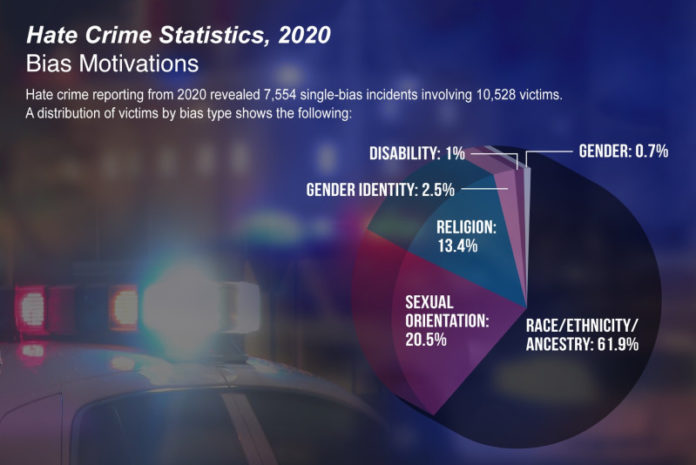
The FBI released Hate Crime Statistics, 2020, the Uniform Crime Reporting (UCR) Program’s latest compilation about bias-motivated incidents throughout the nation. The 2020 data, submitted by 15,136 law enforcement agencies, provide information about the offenses, victims, offenders, and locations of hate crimes.
Law enforcement agencies submitted incident reports involving 7,759 criminal incidents and 10,532 related offenses as being motivated by bias toward race, ethnicity, ancestry, religion, sexual orientation, disability, gender, and gender identity. Please note the UCR Program does not estimate offenses for the jurisdictions of agencies that do not submit reports. Highlights of Hate Crime Statistics, 2020, follow. (Due to rounding, percentage breakdowns may not add to 100%.)
Victims of Hate Crime Incidents
- There were 7,554 single-bias incidents involving 10,528 victims. A percent distribution of victims by bias type shows that 61.9% of victims were targeted because of the offenders’ race/ethnicity/ancestry bias, 20.5% were victimized because of the offenders’ sexual-orientation bias, 13.4% were targeted because of the offenders’ religious bias, 2.5% were targeted because of the offenders’ gender identity bias, 1% were victimized because of the offenders’ disability bias, and 0.7% were victimized because of the offenders’ gender bias.
- There were 205 multiple-bias hate crime incidents that involved 333 victims.
Offenses by Crime Category
- Of the 7,426 hate crime offenses classified as crimes against persons in 2020, 53.4% were for intimidation, 27.6% were for simple assault, and 18.1% were for aggravated assault. Twenty-two (22) murders and 19 rapes were reported as hate crimes. The remaining 27 hate crime offenses were reported in the category of other.
- Of the 2,913 hate crime offenses classified as crimes against property, most (76.4%) were acts of destruction/damage/vandalism. Robbery, burglary, larceny-theft, motor vehicle theft, arson, and other offenses accounted for the remaining 23.6% of crimes against property.
- One hundred ninety-three (193) additional offenses were classified as crimes against society. This crime category represents society’s prohibition against engaging in certain types of activity such as gambling, prostitution, and drug violations. These are typically victimless crimes in which property is not the object.
Known Offenders
In the UCR Program, the term known offender does not imply that the suspect’s identity is known; rather, the term indicates that some aspect of the suspect was identified, thus distinguishing the suspect from an unknown offender. Law enforcement agencies specify the number of offenders and, when possible, the race of the offender or offenders as a group. Beginning in 2013, law enforcement agencies began reporting whether suspects were juveniles or adults, as well as the suspect’s ethnicity when possible.
- Of the 6,431 known offenders, 55.2% were White and 20.2% were Black or African American. Other races accounted for the remaining known offenders: 1.1% were Asian, 1.1% were American Indian or Alaska Native, 0.5% were Native Hawaiian or Other Pacific Islander, and 5.6% were of a group of multiple races. The race was unknown for 16.4%.
- Of the 5,820 known offenders for whom ethnicity was reported, 39.3% were Not Hispanic or Latino, 10.7% were Hispanic or Latino, and 2.5% were in a group of multiple ethnicities. Ethnicity was unknown for 47.5% of these offenders.
- Of the 5,915 known offenders for whom ages were known, 89.1% were 18 years of age or older.
Locations of Hate Crimes
Law enforcement agencies may specify the location of an offense within a hate crime incident as one of 46 location designations. In 2020, most hate crime incidents (28.3%) occurred in or near residences/homes. Nearly 20% (19.9) occurred on highways/roads/alleys/streets/sidewalks, 6.5% happened at parking/drop lots/garages, 4.4% occurred at schools/colleges, 3.6% occurred at parks/playgrounds, and 3.6% took place in churches/synagogues/temples/mosques. The location was reported as other/unknown for 8.6% of hate crime incidents. The remaining 25.1% of hate crime incidents took place at other or multiple locations.
Hate Crime Statistics, 2020 is available as a download on the FBI’s Crime Data Explorer.
















